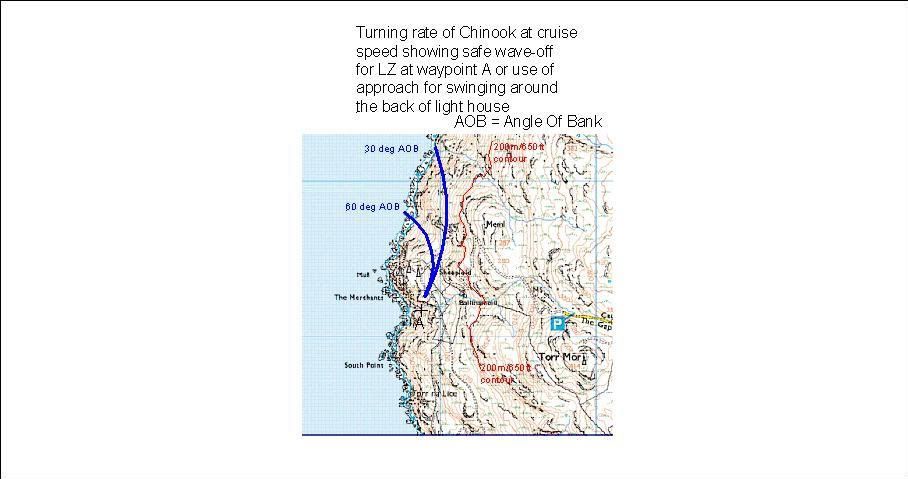Robin Clark
Still you make the error of looking for a turn from the origin to the end points – rather basic, but I will explain again:
for a start, convert all your bearings/headings/etc to magnetic (using var of the time) so that you will be able to recognise any correlations between instruments, etc. and avoid confusion with true bearings;
I will try to explain why the flight as far as waypoint change can be regarded as a straight line followed by a significant turn:
a useful position from the reports was “first fix”, not at the take-off pad but a couple of miles into the flight, from where the bearing to waypoint A was exactly 027 – let us refer to the path between “first fix” and waypoint A as the “027 track” - remembering where the radar site was and that the ATC fix was relative to that, you will find that even the approximate ATC fix had them on this 027 track a few miles after take-off ;
the sighting at Carlough 20 miles into the flight was consistent with their being on this track at that point;
the position of waypoint change was exactly on this 027 track from “first fix”;
“
A” was the waypoint the STANS was using until waypoint change and it is surely obvious that they would have been flying along this track reasonably closely for reasons of efficiency over the sea with no features in the way to need a deviation;
thus it is surely reasonable to assume that we can draw a straight line up until waypoint change;
if we take the last steering calculation position (some seconds before impact, a routine data storage, when the a/c was still in a steady state, as I have previously argued it to be right up until impact) the bearing from exactly waypoint change was 30 – thus a minimum value for the turn of 3 degrees if started instantly at waypoint change;
to have kept to track over such a distance, it is reasonable to assume that the HP's course selector would have been on 027 up at least until waypoint change;
the HP's course selector was found on 035 - allowing a couple of seconds to twiddle the course selector and turn would have extended their track along 027 by a couple of hundred yards at their speed which in turn (that close in) gets the bearing to that position of last altitude update to 035 – either this is an amazing coincidence or the turn onto 035 was intentional.
Further, you wrote <<..it would have required an extremely violent turn in order to avoid Waypoint A....as they were so close. >>
Recently I posted a graphic representation of the turning radii at their speed on a map of the area – at their altitude it was perfectly safe for them to start a moderate (30-60 bank) turn as they passed over the position of waypoint A – it was the optimum point to aim for if you wanted to swing around the lighthouse – the wave-off if you didn't want to actually touch down at the “green triangle” LZ.
Below 800ish ft they were not in oro cloud - the mist was on the slopes but turning in time would have kept them in the clear, probably able to see the lighthouse or its masts intermittently below and to the left - to the right the sloping ground intermittently showing through the surface mist, impossible to judge one's distance off.
At the risk of getting the size wrong, I'll try and post it here again:
 Tuc
Is this relevant to the switch business?
From the “AAIB INVESTIGATION OF THE TRIMBLE TNL 8000 GPS NAVIGATION UNIT”:
<<2.6.2 The facility for switching the main DC power supply for the unit by utilising a lowcurrent/voltage line from the aircraft to an FET within the unit did not function in that it was not possible to switch off the power supply using this facility. Examination of the components showed that the FET had been damaged at some time, it was not possible to say when, by having a high voltage applied to it from the main DC power supply input to the unit The damaged FET was replaced and a bench test performed and this remote switching of the power supply was found to function correctly.>>
Tuc
Is this relevant to the switch business?
From the “AAIB INVESTIGATION OF THE TRIMBLE TNL 8000 GPS NAVIGATION UNIT”:
<<2.6.2 The facility for switching the main DC power supply for the unit by utilising a lowcurrent/voltage line from the aircraft to an FET within the unit did not function in that it was not possible to switch off the power supply using this facility. Examination of the components showed that the FET had been damaged at some time, it was not possible to say when, by having a high voltage applied to it from the main DC power supply input to the unit The damaged FET was replaced and a bench test performed and this remote switching of the power supply was found to function correctly.>>
Last edited by walter kennedy; 28th Jun 2011 at 06:51.
Reason: pelling